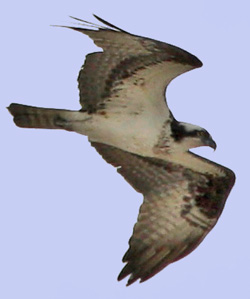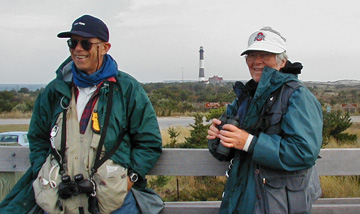|
||||
| Raptors
are fascinating animals. Not too many years ago it was a rare sight to see
a hawk or falcon in the wild. The now-infamous story of the osprey
exemplifies the critical experiences of these species. The story has its
origin on Long Island. Dennis Puleston of Brookhaven Hamlet, a nationally renowned naturalist, became the voice for the dwindling population of osprey. He, and other leading scientists, correlated the increasing levels of pesticides, particularly DDT, with the decline in the reproduction of this magnificent fish hawk. Because these birds were at the high end of the food chain, DDT levels were concentrated in the bodies of these birds, causing the thinning of the shells of their eggs. Reproduction was falling off to near zero. Puleston helped to found the Environmental Defense Fund, leading the battle cry to ban the use of these pesticides. In the early 1970s DDT and similar compounds were banned. The birds began their comeback. |
||||
|
||||
| Today the
osprey, and such similar species as the eagle, peregrine falcon and
others, have made a remarkable return to the landscape. Still, the health
of their populations is always suspect. Habitat loss, encroachment from
human disturbance and competition from other species, as well as the
continued concern over the impact of contaminants, inspires hawk watchers
to maintain a constant vigilance. Famous places like Hawk Mountain in Pennsylvania draw hundreds of hawk watchers every year. The data collected from their observations are valuable to scientists studying these species. A similar program occurs each year right in our own back yard. Fire Island is an important migration route for falcons and hawks. For 22 years, every year from September 10 to November 10 the members of the Fire Island Raptor Enumerators have been counting these species. Associated with the Hawk Migration Association of North America and the Northeast Hawk Watch, these birders collect valuable data on sightings of kestrels, sharp shinned hawks, marsh hawks, peregrines, eagles, ospreys, merlins, coopers hawks, goshawks, red tailed hawks, broad winged hawks and more. |
||||
|
||||
|
Drew Panko and Trudy
Battaly are retired and semi-retired educators, respectively, and
coordinators of the Fire Island hawk watch. On a blustery October day, I
encountered them in the platform at the east end of Robert Moses State
Park as they braved a southwest wind gusting to near 40 mph in search of
raptors. They readily shared their experiences and concerns with me about
the hawks and falcons of Fire Island. "The kestrels seem to be in big trouble," Trudy explained worriedly. "Sharp shins, too, seem to be on the decline. Peregrines seem to be holding their own, and merlins are still abundant," she explained on a good note. Drew opened his data book to show me pages of graphs depicting the population trends of the various species. As we spoke of the importance of their work, and the rewards of birding in general, Drew spotted a harrier, or marsh hawk, as it is more commonly called.
"Is it a male?" he asked Trudy excitedly. Before she could answer, he said it was. "There are two distinct populations. One migrates, and one is resident. It's hard to tell the difference." He continued to explain about the migratory habits of the various species, of the inland and coastal populations of ospreys, how their migration patterns vary and of their excitement at spotting a bald eagle the week before. Along with Trudy we spoke of the relationship of the birds of prey to the ecosystem of the Island and how the numbers reflect the state of the environment. When a whitetail buck appeared under the platform Drew commented about the problems of the growing deer population. It was clear that he and Trudy had a deep understanding of the outdoors. They saw much more than birds through their binoculars. I bid them a good afternoon, confident that the hawks and falcons of Fire Island were in good hands. Hawk watchers are scheduled to participate in the count seven days a week through November 10. For information visit their website at battaly.com/fire or hmana.org.
|
||||
|
Osprey Photo by
Trudy Battaly |

